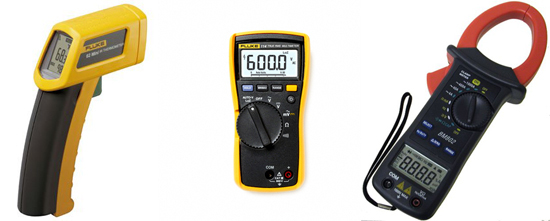Lamptron FC-8 Fan Controller Review
Testing Methodology & Results
Testing Methodology
Being a bit of a fan-atic myself, I’ve tested fans in the past and I easily have a small collection of them. Though for this review I ran into a bit of a problem; how am I going to load up every channel to 30w? Well, I just so happen to have a box of Yate Loon fans (64 to be exact) that are all from servers that I used.
Testing Equipment:
- 8 Yate Loon D12SH-12s per channel
- Fluke 62 Mini Digital Infrared Thermometer
- Fluke 114 True RMS Digital Multimeter
- Sinometer MS2138R AC/DC Clamp Meter
Testing Parameters
- Output at least 28.4w per channel
- Keep 12v output voltage a close to the nominal value supplied by the PSU used.
- Compatibility with a variety of fans tested
- Compatibility with cases
- Ease of use for included functions

There are the tools I will be using for the job. The Fluke 114 & Sinometer MS2138R are going to be used in tangent to get my power measurements. Volts x Amps = Watts, and since this controller has each channel rated by watts I need to take actual voltage measurements and amperage measurements to get an accurate result of how much stress I am adding onto the controller’s channel. This controller also advertises low heat output; because of the design, the MOSFETs on the back of the controller should be the part producing the most heat as that is where the fans are drawing their current from. I will use the Fluke 62 to measure the temperature in Degrees Celsius (#*C) to gauge on a rise above ambient how warm these MOSFETs are getting.
To gather my measurements I will be using Eight Yate Loon D12SH-12 fans per channel over a 24 hour period to see if this controller can sustain its rated output in a continuous operating environment. The ambient testing temperature is 35*C and is artificially kept at that temperature. My Silverstone Strider Plus 750w will be providing voltage and amperage to the controller. All voltage and amperage measurements will be taken periodically, every 6 hours, and averaged together. The Yate Loons will provide a current draw of 0.3 Amps each, for a total of 2.4 Amps (28.4w if the 12v rail holds steady at 12v). This controller is rated for 30w (which divided by 12 is 2.5 Amps), so it will be pushed to its limits as closely as possible by me.
Now let’s move onto the actual testing.

With the source voltage measured at 12.01v we are seeing a slight rise on this controller from the voltage output. On normal resistor based controllers, like what has been sold in the past, you normally see a drop in voltage.

Here we have the measured temps of the MOSFETs of each channel on the controller; at peak we see a 5.6*C rise over ambient. This is a great result indeed. Older controller designs offered the same amount of wattage per channel, but those would have a 15-20*C rise over ambient which is something you do not want with a fan controller. Being wedged in the 5.25″ bay of your case means those controllers would not get any airflow. Lamptron’s PWM Control method alleviates these worries as it only has a minor temperature rise, giving it that advertised “cool operations.”
The results are in and I have made up my mind; let us move onto the next page and wrap things up.

Comments are closed.